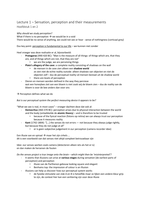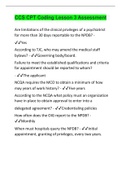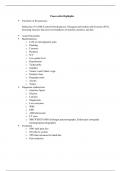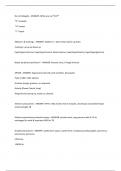Musculoskeletal diseases
In this report I will be discussing three musculoskeletal diseases in which how
these diseases can impact the musculoskeletal system and how the muscles
bring out movement of joints. Adding on to that, the Musculoskeletal system is
an organ system that allows movement by utilising the muscular and skeletal
systems. Furthermore, it allows the body to have stability, support, form, and
movement. The three Musculoskeletal diseases I have chosen to talk about in
this report are: Osteomyelitis (which is an infection in the bone caused by an
infection or fungi), Rheumatoid Arthritis (which is when the immune system
attacks and destroys joints and cartilage) and Osteomalacia (which is a vitamin
D defiency softening the bones). Throughout this report you will get a detailed
overview of the physiology of the human body and how certain diseases can
affect the functioning of the musculoskeletal system. Lastly, towards the end of
this report I will provide a deep evaluation for Rheumatoid Arthritis giving a
variety of treatments to treat the disease effectively to educate employees about
a variety of diseases.
What is the musculoskeletal system and how does it work?
The musculoskeletal system (locomotor system) is a part of the human body
that allows movement, maintain shape, support, protection, mineral storage, and
the production of blood cells. This is made up from ligaments, cartilage, bones
of the skeleton, tendons, muscles, joints, and other connective tissues in the
body. The musculoskeletal system is separated into two major groups:
- The muscular system encompasses all the body's muscles. Skeletal muscles, in
particular, are responsible for producing movement by acting on the body's
joints. Moreover, to produce movement agonist muscles shorten with
contraction. After the contraction the antagonist muscle, which is paired with
the agonist muscle for example biceps and triceps, returns the limb to its
previous position following the contraction. Furthermore, Synergist muscles
such as biceps brachii and the brachialis work together with agonist muscles to
produce motion like or in concert with agonist muscles, allowing for a wide
range of possible movements.
- The bone is the most important component of the skeletal system. Our bodies
have a hard-core, yet movable, skeleton made up of bones that articulate with
one other and form joints. The accessory structures, such as articular cartilage,
ligaments, and bursae support the integrity and function of the bones and joints.
The musculoskeletal system serves a variety of functions in addition to
providing stability and mobility to the body. The skeletal system is involved in
other homeostatic functions such as mineral storage (e.g., calcium) and
haematopoiesis. Bones are made of minerals and serve as a mineral store for
calcium and phosphorous, which can be given up if the body needs the minerals
for other functions. Not only does the musculoskeletal system store minerals it
, Unit 8 Biology assignment A
aids your bones to create blood cells as the marrow inside of the bone helps the
production of both red blood cells and white blood cells.
Additionally, the skeletal system's bones protect the body's internal organs such
as the ribs which protects the lungs and the heart, the cranium which protects
the brain and the backbone which protects the spinal cord.
Muscular system
Muscle tissue is a type of specialised contractile tissue that makes up the
muscular system. Muscle tissue is classified into three categories, depending on
which all muscles are divided into three classes.
- The muscular layer of the heart is made up of cardiac muscle (myocardium)
- The smooth muscle that lines the insides of blood vessels and hollow organs
is called smooth muscle.
- Skeletal muscle is a type of muscle that attaches to the bones and allows for
voluntary movement.
Subsequently, the muscular system's primary job is to allow the body to move.
The musculoskeletal system can conduct a variety of movements depending on
the axis and plane in which they are performed. The following are a few of the
most important:
- Flexion and extension are movements in which the angle between the bones
engaged in the action is decreased or increased, respectively. This motion
revolves around a frontal axis in the sagittal plane. Bending the leg at the knee
which is a hinge type synovial joint is an example of flexion, whereas
straightening the knee from a flexed posture is an example of extension.
-Adduction and abduction are motions in which sections of the body are
brought closer to or further away from the midline. These movements revolve
around a sagittal axis in the frontal plane. Abduction of the arm at the shoulder
joint (which is a type of ball and socket joint, for example, is the movement of
the arm away from the side of the body, whereas adduction is the movement of
the arm back towards the body.
-In the transverse plane, rotation is the movement of a part of the body around
its vertical (longitudinal) axis. A type of joint that rotates is pivot joint as this
joint allows rotation to occur either within the ring or the ring may rotate around
the bone. Internal rotation includes rotating the segment towards the midline,
and external rotation involves moving it away from the midline. A lateral
rotation of the thigh is an example.
- Supination and pronation are two different forms of rotatory movements that
are commonly used to describe forearm movements. Supination is a lateral
forearm rotation that turns the palms anteriorly (if the arm is in anatomical






